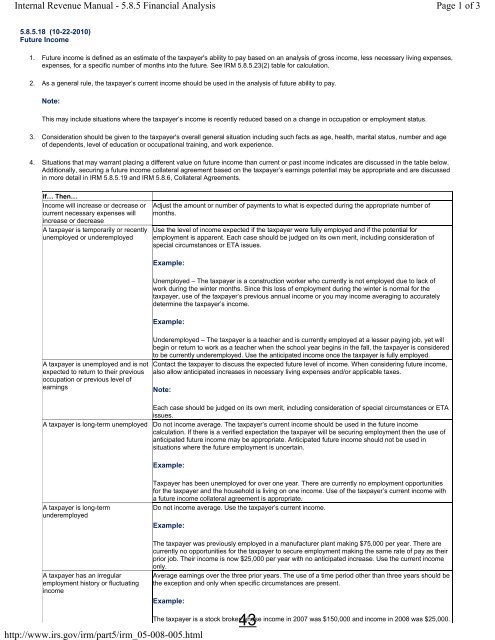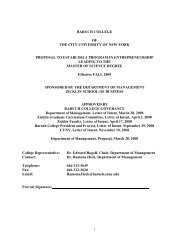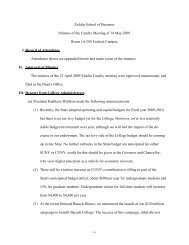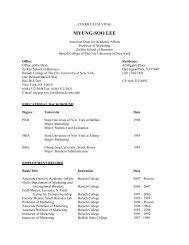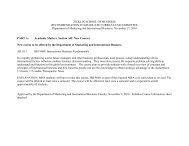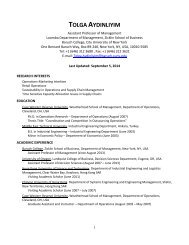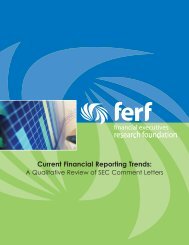Tax Seminar #3 – December 3 2012
Workbook - Zicklin School of Business
Workbook - Zicklin School of Business
You also want an ePaper? Increase the reach of your titles
YUMPU automatically turns print PDFs into web optimized ePapers that Google loves.
Internal Revenue Manual - 5.8.5 Financial Analysis<br />
Page 1 of 3<br />
5.8.5.18 (10-22-2010)<br />
Future Income<br />
1. Future income is defined as an estimate of the taxpayer's ability to pay based on an analysis of gross income, less necessary living expenses,<br />
expenses, for a specific number of months into the future. See IRM 5.8.5.23(2) table for calculation.<br />
2. As a general rule, the taxpayer’s current income should be used in the analysis of future ability to pay.<br />
Note:<br />
This may include situations where the taxpayer’s income is recently reduced based on a change in occupation or employment status.<br />
3. Consideration should be given to the taxpayer's overall general situation including such facts as age, health, marital status, number and age<br />
of dependents, level of education or occupational training, and work experience.<br />
4. Situations that may warrant placing a different value on future income than current or past income indicates are discussed in the table below.<br />
Additionally, securing a future income collateral agreement based on the taxpayer’s earnings potential may be appropriate and are discussed<br />
in more detail in IRM 5.8.5.19 and IRM 5.8.6, Collateral Agreements.<br />
If… Then…<br />
Income will increase or decrease or<br />
current necessary expenses will<br />
increase or decrease<br />
A taxpayer is temporarily or recently<br />
unemployed or underemployed<br />
Adjust the amount or number of payments to what is expected during the appropriate number of<br />
months.<br />
Use the level of income expected if the taxpayer were fully employed and if the potential for<br />
employment is apparent. Each case should be judged on its own merit, including consideration of<br />
special circumstances or ETA issues.<br />
A taxpayer is unemployed and is not<br />
expected to return to their previous<br />
occupation or previous level of<br />
earnings<br />
Example:<br />
Unemployed <strong>–</strong> The taxpayer is a construction worker who currently is not employed due to lack of<br />
work during the winter months. Since this loss of employment during the winter is normal for the<br />
taxpayer, use of the taxpayer’s previous annual income or you may income averaging to accurately<br />
determine the taxpayer’s income.<br />
Example:<br />
Underemployed <strong>–</strong> The taxpayer is a teacher and is currently employed at a lesser paying job, yet will<br />
begin or return to work as a teacher when the school year begins in the fall, the taxpayer is considered<br />
to be currently underemployed. Use the anticipated income once the taxpayer is fully employed.<br />
Contact the taxpayer to discuss the expected future level of income. When considering future income,<br />
also allow anticipated increases in necessary living expenses and/or applicable taxes.<br />
Note:<br />
Each case should be judged on its own merit, including consideration of special circumstances or ETA<br />
issues.<br />
A taxpayer is long-term unemployed Do not income average. The taxpayer’s current income should be used in the future income<br />
calculation. If there is a verified expectation the taxpayer will be securing employment then the use of<br />
anticipated future income may be appropriate. Anticipated future income should not be used in<br />
situations where the future employment is uncertain.<br />
Example:<br />
A taxpayer is long-term<br />
underemployed<br />
<strong>Tax</strong>payer has been unemployed for over one year. There are currently no employment opportunities<br />
for the taxpayer and the household is living on one income. Use of the taxpayer’s current income with<br />
a future income collateral agreement is appropriate.<br />
Do not income average. Use the taxpayer’s current income.<br />
Example:<br />
A taxpayer has an irregular<br />
employment history or fluctuating<br />
income<br />
The taxpayer was previously employed in a manufacturer plant making $75,000 per year. There are<br />
currently no opportunities for the taxpayer to secure employment making the same rate of pay as their<br />
prior job. Their income is now $25,000 per year with no anticipated increase. Use the current income<br />
only.<br />
Average earnings over the three prior years. The use of a time period other than three years should be<br />
the exception and only when specific circumstances are present.<br />
Example:<br />
http://www.irs.gov/irm/part5/irm_05-008-005.html<br />
43<br />
The taxpayer is a stock broker whose income in 2007 was $150,000 and income in 2008 was $25,000.


